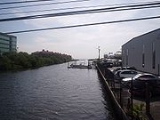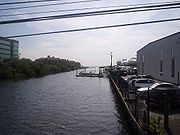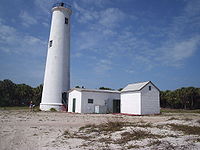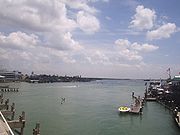
Great Gale of 1848
Encyclopedia



Tropical cyclone
A tropical cyclone is a storm system characterized by a large low-pressure center and numerous thunderstorms that produce strong winds and heavy rain. Tropical cyclones strengthen when water evaporated from the ocean is released as the saturated air rises, resulting in condensation of water vapor...
that struck Florida
Florida
Florida is a state in the southeastern United States, located on the nation's Atlantic and Gulf coasts. It is bordered to the west by the Gulf of Mexico, to the north by Alabama and Georgia and to the east by the Atlantic Ocean. With a population of 18,801,310 as measured by the 2010 census, it...
in September 1848. It affected the Tampa Bay Area
Tampa Bay Area
The Tampa Bay Area is the region of west central Florida adjacent to Tampa Bay. Definitions of the region vary. It is often considered equivalent to the Tampa-St. Petersburg-Clearwater Metropolitan Statistical Area defined by the United States Census Bureau. The Census Bureau currently...
September 23–25, 1848. It crossed the Florida Peninsula to cause damage on the east coast on or about September 26. It reshaped parts of the coast and destroyed much of what few human works and habitation were then in the Tampa Bay Area
Tampa Bay Area
The Tampa Bay Area is the region of west central Florida adjacent to Tampa Bay. Definitions of the region vary. It is often considered equivalent to the Tampa-St. Petersburg-Clearwater Metropolitan Statistical Area defined by the United States Census Bureau. The Census Bureau currently...
. Although its recorded wind speed was that of a Category 1 storm on the Saffir-Simpson Hurricane Scale
Saffir-Simpson Hurricane Scale
The Saffir–Simpson Hurricane Scale , or the Saffir–Simpson Hurricane Wind Scale , classifies hurricanes — Western Hemisphere tropical cyclones that exceed the intensities of tropical depressions and tropical storms — into five categories distinguished by the intensities of their sustained winds...
, its barometric pressure and storm surge were consistent with at least a Category 4 hurricane. It was described by one survivor
William Whitaker (pioneer)
William Henry Whitaker was an American Seminole War veteran and pioneer who, under the provisions of the Armed Occupation Act, established the first permanent settlement in what is now Sarasota, Florida. There he traded mullet with Cubans to bring the first groves of economically important oranges...
as, “the granddaddy of all hurricanes.” (Grismer, 35)
Meteorological history
The storm appears to have formed in the central Gulf of Mexico, before moving northeast to make land fall near Clearwater, FloridaClearwater, Florida
Clearwater is a city located in Pinellas County, Florida, US, nearly due west of Tampa and northwest of St. Petersburg. In the west of Clearwater lies the Gulf of Mexico and in the east lies Tampa Bay. As of the 2000 census, the city had a total population of 108,787. It is the county seat of...
. It then crossed the Florida peninsula and exited near Cape Canaveral
Cape Canaveral
Cape Canaveral, from the Spanish Cabo Cañaveral, is a headland in Brevard County, Florida, United States, near the center of the state's Atlantic coast. Known as Cape Kennedy from 1963 to 1973, it lies east of Merritt Island, separated from it by the Banana River.It is part of a region known as the...
. After moving into the extreme western Atlantic, the cyclone continued to the northeast just offshore the East coast of the United States
United States
The United States of America is a federal constitutional republic comprising fifty states and a federal district...
to the Grand Banks of Newfoundland.
Gulf of Mexico
A brig was dismasted north of Cedar Key, within 80 miles of St. Marks. (Ludlum) Various bay and keys were changed significantly, as detailed below. This hurricane rendered existing maps of the Tampa Bay area useless to mariners.Florida
The wind speed was measured at 72 mph at its highest and the barometerBarometer
A barometer is a scientific instrument used in meteorology to measure atmospheric pressure. Pressure tendency can forecast short term changes in the weather...
read 28.18 inches at its lowest (at Fort Brooke). The storm produced the highest tide ever experienced in Tampa Bay
Tampa Bay
Tampa Bay is a large natural harbor and estuary along the Gulf of Mexico on the west central coast of Florida, comprising Hillsborough Bay, Old Tampa Bay, Middle Tampa Bay, and Lower Tampa Bay."Tampa Bay" is not the name of any municipality...
. The water rose and fell about 15 feet in 6 to 8 hours. Pinellas County was inundated “at the waist” and “the bays met.” General R. D. A. Wade, commanding at Fort Brooke
Fort Brooke
Fort Brooke was a historical military post situated on the east bank of the Hillsborough River in present-day Tampa, Florida. The Tampa Convention Center currently stands at the site.-Fort Brooke as a military outpost:...
reported the destruction of the wharves, public buildings, and storehouses. B. P. Curry, the fort’s assistant surgeon, reported the hospital destroyed. Only five houses were left standing in Tampa, and they were all damaged. The water rose twelve feet higher than had been noted in the past. (Pizo 19)
At Englewood, Florida
Englewood, Florida
Englewood is a census-designated place in Charlotte and Sarasota counties in the U.S. state of Florida. As of the 2000 census, it had a population of 16,196.Englewood also was the original name for Vineland, Florida...
, Stump Pass was cut. Casey’s Pass was opened at Venice, Florida
Venice, Florida
Venice is a city in Sarasota County, Florida, United States. According to the U.S. Census Bureau's 2007 estimates, the city had a population of 21,015. It is noted for its large snowbird population. Its newspaper is the Venice Gondolier Sun...
. New Pass was opened between Sarasota Bay
Sarasota Bay
Sarasota Bay is an estuary located off the west coast of Florida in the United States.The bay and its surrounding area appeared on the earliest maps of the area, being named Zarazote on one dating from the early 18th century...
and the Gulf, splitting Palm Island into Longboat and Lido Keys. Allen’s Creek was widened from less than 200 feet to about half a mile at its mouth. The fish rancho of Antonio Maximo Hernandez , reputedly lower Pinellas’ first white settler, was destroyed. Passage Key, between Egmont Key
Egmont Key State Park
Egmont Key State Park is a Florida State Park located on Egmont Key, at the mouth of Tampa Bay, in the state of Florida, United States. It lies southwest of Fort DeSoto Park. It can only be reached by boat or ferry. The Egmont Key Lighthouse and the ruins of Fort Dade, a Spanish-American War era...
and Anna Maria
Anna Maria, Florida
Anna Maria, is a city in Manatee County, Florida, United States. The population was 1,814 at the 2000 census. According to the 2005 U.S. Census Bureau's estimates, the city grew slightly to 1,867. The city occupies the northern part of Anna Maria Island and is one of three municipalities on the...
was obliterated but reformed later.
The storm created what would become known as “Soldier’s Hole” at Mullet Key, so called because soldiers at Fort De Soto used it as a swimming hole. John’s Pass was opened but has since shifted north. After the storm destroyed the lighthouse on Egmont Key, the keeper (Marvel Edwards) rode out the storm in a rowboat tied to a palmetto tree. The end of the rope was later found 9 feet off the ground, which had an elevation of about 6 feet. The Tocobaga
Tocobaga
Tocobaga was the name of a chiefdom, its chief and its principal town during the 16th century in the area of Tampa Bay. The town was at the northern end of what is now called Old Tampa Bay, an arm of Tampa Bay that extends northward between the present-day city of Tampa and Pinellas County...
mound on Odette Phillippe’s property in what is now Safety Harbor, Florida
Safety Harbor, Florida
Safety Harbor is a city on the west shore of Tampa Bay in Pinellas County, Florida, United States. It was incorporated in 1917. The population was 17,203 at the 2000 census. As of 2004, the population estimated by the U.S. Census Bureau is 17,550....
was damaged. All the trees along what is now Indian Rocks Road in Largo, Florida
Largo, Florida
Largo is the third largest city in Pinellas County, Florida, USA and is part of the Tampa Bay Area. Centrally located, it is the crossroads of the county. As of the 2000 census, the City had a total population of 69,371. As of 2004, the population estimated by the U.S. Census Bureau was...
were knocked down. (Largo, 148) The cost of replacing the Egmont Key lighthouse and a strong box lost from W. G. Ferris totaled US$19,500 (1848 dollars). (Barnes)
Damage on the east coast may have been less severe., though it was described in the Savannah Republican as, “blowing ‘great guns’ - the hardest blow felt [on the St. Johns River
St. Johns River
The St. Johns River is the longest river in the U.S. state of Florida and its most significant for commercial and recreational use. At long, it winds through or borders twelve counties, three of which are the state's largest. The drop in elevation from the headwaters to the mouth is less than ;...
] for several years." It blew down houses in Jacksonville, Florida
Jacksonville, Florida
Jacksonville is the largest city in the U.S. state of Florida in terms of both population and land area, and the largest city by area in the contiguous United States. It is the county seat of Duval County, with which the city government consolidated in 1968...
and caused flooding in St. Augustine, Florida
St. Augustine, Florida
St. Augustine is a city in the northeast section of Florida and the county seat of St. Johns County, Florida, United States. Founded in 1565 by Spanish explorer and admiral Pedro Menéndez de Avilés, it is the oldest continuously occupied European-established city and port in the continental United...
, as well as interfering with shipping on the river.
See also
- 1840-1849 Atlantic hurricane seasons1840-1849 Atlantic hurricane seasons1820s 1830s 1840s 1850s 1860s-1840 Atlantic hurricane season:I. On June 19, a tropical storm hit near Lake Charles, Louisiana.II. A hurricane hit near the mouth of the Rio Grande, destroying villages and causing flooding....
- Saffir-Simpson Hurricane ScaleSaffir-Simpson Hurricane ScaleThe Saffir–Simpson Hurricane Scale , or the Saffir–Simpson Hurricane Wind Scale , classifies hurricanes — Western Hemisphere tropical cyclones that exceed the intensities of tropical depressions and tropical storms — into five categories distinguished by the intensities of their sustained winds...
Printed media
- Barnes, Jay. Florida's Hurricane History. University of North Carolina Press. Chapel Hill, 1998. Pages 61–62.
- Fuller, Walter P. St. Petersburg and its People. Great Outdoors Publishing. St. Petersburg, 1972. Pages 48 – 50.
- Google Earth. July 27, 2006.
- Grismer, Karl, The Story of Sarasota. The Florida Grower Press. Tampa, 1946.
- Largo Bicentennial Book Committee. (LBBC1979)Largo, then till . . . . Largo Area Historical Society. 1979.
- Ludlum, David McWilliams. ‘’Early American hurricanes‘’, 1492-1870. American Meteorological Society. Boston, 1963. ISBN : 0933876165
- Pizo, Anthony P. Tampa Town, 1824- -1886 The Cracker Village with a Latin Accentt. Hurricane Press Publishers. Miami, 1969.

